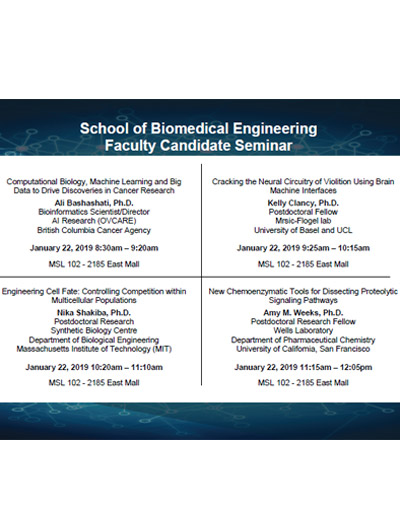
- This event has passed.
BME and BME/MSL: Faculty Candidate Seminars
January 22, 2019 @ 8:30 am - 12:05 pm

The School of Biomedical Engineering and the Michael Smith Laboratories present Faculty Candidate Seminars:
Date: Tuesday, January 22, 2019
Time: 8:30 AM – 12:05 PM
Location: Michael Smith Laboratories Auditorium, Room 102
Ali Bashashati, Ph.D.
Bioinformatics Scientist/Director AI Research (OVCARE)
British Columbia Cancer Agency
Title: Computational Biology, Machine Learning and Big Data to Drive Discoveries in Cancer Research
Abstract: Advances in genomic sequencing technologies in the last decade have revolutionized the field of medicine, especially cancer research, by producing large amounts of genetic information. These technological developments in raw sequencing data generation have far outpaced the progress in the downstream analysis methods. As a result, the bottleneck to gaining new biological insights from interrogation of sequencing data has shifted from data generation to data analysis.
In this presentation, I will:
- Provide insights into some of the algorithms and big data analytics software infrastructure that we have developed for handling sequencing data.
- Highlight the application of our algorithms and big data analytics pipelines to drive discoveries in cancer with specific focus on ovarian cancer. Our work in ovarian cancer has led to a break-through in the identification of patients who do not respond to conventional therapies (published in Nature Genetics – Top 10 Research Stories of 2017, Canadian Cancer Society).
- Map out my future directions in computational biology and machine learning applied to various biomedical areas.
Time: 8:30 AM – 9:20 AM
Kelly Clancy, Ph.D.
Postdoctoral Fellow Mrsic-Flogel lab
University of Basel and UCL
Title: Cracking the Neural Circuitry of Volition Using Brain Machine Interfaces
Abstract: The experience of volition – of having control over one’s self and environment – is integral to our sense of self and responsibility, and its dysfunction in a number of psychopathologies can have devastating social effects. The fluency of our control over external objects is informed by our sensory experience of them, in a continuous dialog between action and perception. How such control is represented at the neuronal level, or its efficacy judged, however, is not understood. In this talk, I will discuss studies in which I have begun to explore these topics using brain-machine interfaces (BMIs). BMIs are a promising tool for neurological applications, but also a powerful technique for revealing how the brain learns, as well as how it controls its own activity. We’ve developed several imaging-based BMI tasks in mice that enable us to monitor brain activity in single cells and across the cortex as animals learn to control neural firing, allowing us to bridge the gap between the dynamics of individual neurons with cortex-wide activity patterns. We used these methods to screen for cortical areas implicated in the BMI task to reveal how brain areas coordinate their activity to effect causal control.
Time: 9:25 AM – 10:15 AM
Nika Shakiba, Ph.D.
Postdoctoral Researcher Synthetic Biology Center, Department of Biological Engineering
Massachusetts Institute of Technology (MIT)
Title: Engineering Cell Fate: Controlling Competition within Multicellular Populations
Abstract: As evolution guided the development of multicellular animals by uniting unicellular organisms, single cells have had to adapt their social interactions and engage in mainly co-operative relationships with their neighbours. Nevertheless, remnants of natural selection and competition have remained an innate component of cell-cell interactions and govern the dynamics of cell populations. In the era of cellular engineering, where scientists can direct cell behaviour by engineering gene regulatory networks, cell competition remains an unexplored parameter by which we may be able to control population dynamics. Perhaps the most prominent example of cellular engineering is the recent discovery of induced pluripotent stem cells (iPSCs) in a process called reprogramming – a discovery which was recognized with a Nobel Prize in 2012. iPSCs provide an interesting model system in which to probe the impact of key transcription factors on cell competition outcomes. In this talk, I will take a reverse engineering approach to explore the role of cell competition in reprogramming, utilizing a combined cellular barcoding, mathematical modelling, and lineage tracing strategy. Then, I will discuss ongoing synthetic biology efforts to forward engineer cell fate in a predictable manner through feedback-mediated genetic circuits and a novel active DNA barcoding platform.
Time: 10:20 AM – 11:10 AM
Amy M. Weeks, Ph.D.
Burroughs Wellcome Fund Postdoctoral Research Fellow Wells Laboratory Department of Pharmaceutical Chemistry
University of California, San Francisco
Title: New Chemoenzymatic Tools for Dissecting Proteolytic Signaling Pathways
Abstract: Proteolysis is a key post-translational modification that regulates a wide array of biological processes in human health and disease, including viral infection, cancer progression, organismal development, and neurodegeneration. However, few tools are available to identify proteolysis sites with single amino acid resolution. We have developed next-generation enzymatic tools that enable unbiased capture and sequencing of neo-N termini generated by proteolytic cleavage. These probes are based on subtiligase, a rationally designed variant of the serine protease subtilisin, which catalyzes a ligation reaction between a peptide ester and the N-terminal amine of a peptide or protein. We characterized ligation efficiency for >25,000 enzyme-substrate pairs, leading to the identification of a panel of subtiligase variants that enhance sequence coverage of the cellular N terminome. We have also developed a strategy for spatially-restricted N-terminal tagging that enables global analysis of proteolytic cleavage events at the plasma membrane. Using this technique, we have sequenced proteolytic cleavage sites in >500 human membrane proteins. By combining plasma membrane-targeted subtiligase with pharmacological protease inhibitor treatment, we have begun to define the proteases responsible for specific cleavage events. In combination with its ease of use, the high specificity and resolution of live-cell, subtiligase-catalyzed proteolysis mapping provide a powerful tool for dissecting proteolytic signaling pathways.
Time: 11:15 AM – 12:05 PM